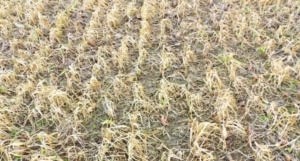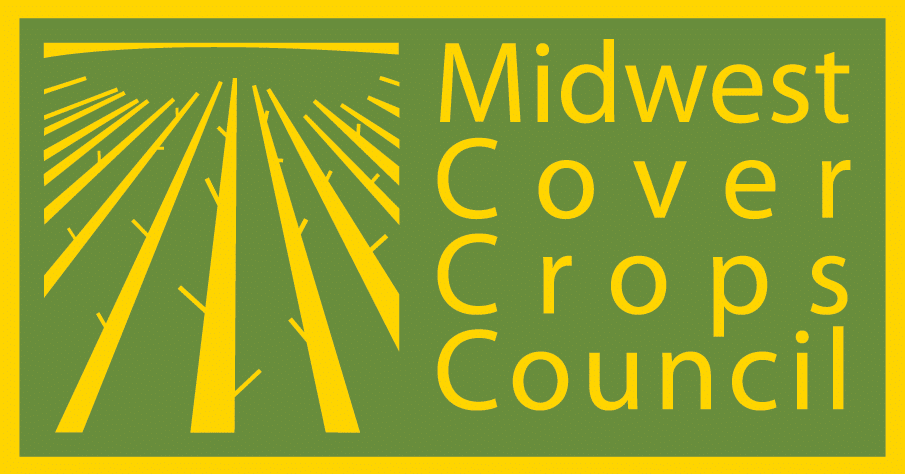Midwest Cover Crops Council (MCCC-104)
Iowa State University Extension (CROP 3159)
This publication is intended to provide a starting point for farmers who are new to growing cover crops. With experience, farmers may fine-tune the use of cover crops for their systems.
Introduction
The following recipe provides an introductory approach to integrating a cover crop into a soybean-corn rotation. Often the easiest place to begin is to plant a cover crop ahead of a soybean cash crop following corn, so consider starting with the companion recipe titled Post Corn, Going to Soybean: Use Cereal Rye (publication MCCC-103; see Resources).
Planning and Preparation
- Planning—Read about cover crops. Go to field days. Start small. Be timely. Prioritize management based on purpose and objectives.
- Soybean cultivar and planting—If possible, plant preceding soybean crop early and use an early-maturity-group cultivar. Some possible strategies are to try cover crops in a field that is usually harvested first, on sloping ground, or where you plan to plant your earliest-maturity-group soybean cultivar.
- Residual soybean herbicides—Oats can be planted in the fall and produce a successful stand following spring application of most residual soybean herbicides. If the oats are grazed, there are some time-interval restrictions. (See Resources.)
- Seed purchase—Order oat seed early, usually by early August. Named oat varieties can produce substantially more growth, but they are usually more expensive than VNS (variety not stated) seed. Use good quality seed that has been cleaned, tested for germination and weed seed contamination, and purchased from a reputable seed dealer.
Fall Work
- Soybean harvest—Harvest fields where oats are to be planted as early as possible. This is not as critical if cover crops are seeded before harvest.
- Tillage or no-tillage—Generally, it is easier to integrate cover crops into no-till or strip-till systems. If full-width tillage is planned, it should be delayed until after the oats are killed by freezing in late fall to allow time for oat cover crop growth. Usually it is more desirable to delay tillage until spring to maintain surface cover and prevent erosion.
- Timing of planting—Oats are relatively frost tolerant but are not winter hardy. In general, oats will grow well in the fall if they are planted at least six weeks before the average hard frost date (28ºF). To allow for adequate growth, in northern Iowa this should be before September 9; in central Iowa, before September 16; and in southern Iowa, before September 23. (See Cover Crop Management publication in Resources.)
- Seeding rate—Minimum seeding rate: 60 lbs./acre. Beginners should consider higher seeding rates for broadcast seeding methods with or without incorporation. Note that these rates assume the seed will have germination rates greater than 85%.
- Planting method—Aerial seed with a plane or helicopter or broadcast/drop seed with a ground-based vehicle into the standing soybean crop. In most of Iowa, aerial or broadcast seeding should take place in late August and/or just before soybean leaves begin to yellow. Rainfall after seeding is essential for establishment, but normal average weekly rainfall totals in Iowa decrease as fall progresses, so in most years, it is usually better to seed late in August rather than wait for leaf yellowing.
- Alternative planting method—Drill to a depth of 0.75–1.50 inches or broadcast with shallow incorporation to less than 1.50 inches immediately after soybean harvest but before recommended dates above. For this method, the seeding rate is also 60 lbs./acre.
- Scouting—In the fall, scout your oat cover crop to determine how well it is growing and its coverage.
- Fertility or liming—Surface applying P, K, or lime before the ground freezes can be done without harming the cover crop too much if the soil is not too wet, although some damage will occur in the wheel tracks. If P, K, or N fertilizer, or manure is injected in the fall, it is usually best to wait until after the cover crop has winter-killed. In this case, use a low-disturbance applicator to minimize incorporation of surface residues.

Spring Work
- Scouting before planting—In the spring, scouting relative to the cover crop is usually not needed because it has winter-killed.
- Termination—Unlike overwintering cover crops, oats winter-kill, so termination is not needed.
- Corn planting—Almost all modern row planters are fully capable of planting corn into a dead oat cover crop and soybean residues without preplant tillage. Row cleaner attachments can sometimes be beneficial to increase soil warming. As usual, check planting depth and seed furrow closure shortly after beginning to plant because some adjustments may be needed with higher residue levels.
- Starter fertilizer—If N fertilizer has not been applied before planting, consider equipping your corn planter with a 2×2 starter fertilizer applicator and aim for a starter fertilizer rate between 30–50 pounds of actual N per acre.
- Scouting after planting—As usual, scout for corn emergence, population, and insect pests after planting. Additionally, scout for weeds because substantial oat and soybean residue may delay emergence of annual weeds, which may then delay the application of post-emergence herbicides.
Resources
Cover Crop Selector Tool — available from the Midwest Cover Crops Council
Cover Crop Management (Iowa Agronomy Technical Note 38)—available from the USDA Natural Resources Conservation Service
Effect of residual herbicides on cover crop establishment (Iowa State Extension and Outreach Integrated Crop Management Encyclopedia Article)
Post Corn, Going to Soybean: Use Cereal Rye (Iowa Cover Crop Recipe series, MCCC-103)—available from the Midwest Cover Crops Council
Authors
Tom Kaspar, USDA-ARS (retired); Mark Licht, Iowa State University (Note: This publication was adapted with consent from MCCC under a joint project to produce customized introductory guidance about cover crops for all member states/provinces.)
Reviewers and Contributors
Shalamar Armstrong, Purdue University; Marisol Berti, North Dakota State University; Eileen Kladivko, Purdue University; Keith Kohler, USDA-ARS; Anna Morrow, Midwest Cover Crops Council; DeAnn Presley, Kansas State University; Vaughn Sothman, Sharp Brothers Seed Co., Kansas; and Anne Verhallen, Ontario Ministry of Food and Agriculture
Acknowledgments
This publication was developed with contributions and collaboration from Iowa Learning Farms and Practical Farmers of Iowa.
The Midwest Cover Crops Council (www.https://www.midwestcovercrops.org) aims to facilitate widespread adoption of cover crops throughout the Midwest by providing educational/outreach resources and programs, conducting new research, and communicating about cover crops to the public.
Funding for this project was provided by McKnight Foundation.
Revised May 2019
The U.S. Department of Agriculture (USDA) prohibits discrimination in all its programs and activities on the basis of race, color, national origin, age, disability, and where applicable, sex, marital status, familial status, parental status, religion, sexual orientation, genetic information, political beliefs, reprisal, or because all or a part of an individual’s income is derived from any public assistance program. (Not all prohibited bases apply to all programs.) Persons with disabilities who require alternative means for communication of program information (Braille, large print, audiotape, etc.) should contact USDA’s TARGET Center at (202) 720-2600 (voice and TDD). To file a complaint of discrimination write to USDA, Director, Office of Civil Rights, 1400 Independence Avenue, S.W., Washington, D.C. 20250-9410 or call (800) 795-3272 (voice) or (202) 720-6382 (TDD). USDA is an equal opportunity provider and employer. ©2019 by MCCC. All rights reserved.
